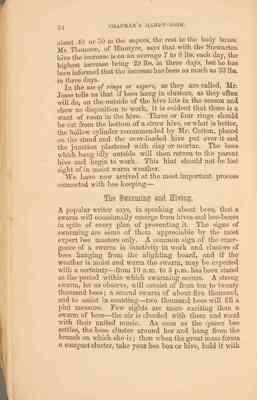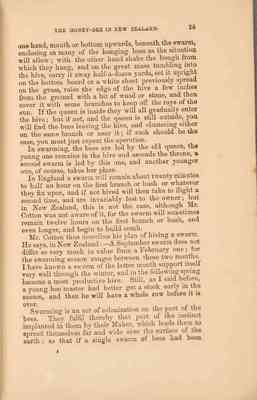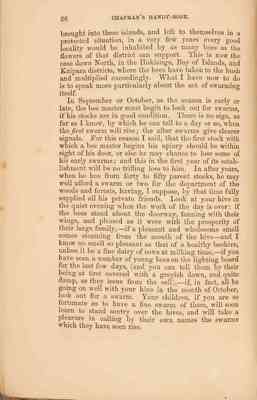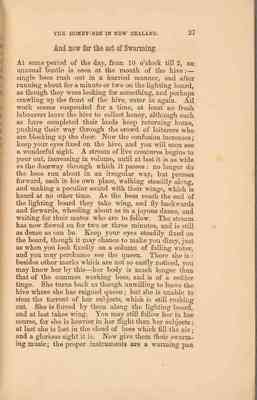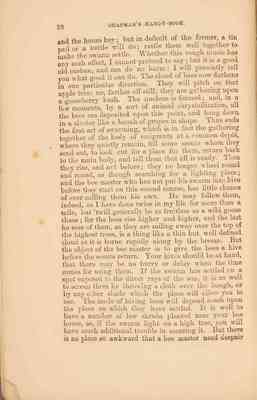Pages
about 40 or 50 in the supers, the rest in the body boxes. Mr Thomson, of Blantyre, says that with the Stewarton hive the increase is on average 7 to 8 lbs each day, the highest increase being 29 lbs. in 3 days, but he has been informed that the increase has been as much as 33 lbs. in three days.
In the use of rings or supers, as they are called, Mr. Jesse tells us that if bees hang in clusters, as they often will do, on the outside of the hive late in the season and show no disposition to work, it is evident that there is a want of room in the hive. Three or fours rings should be cut from the bottom of a straw hive, or what is better, the hollow cylinder recommended by Mr. Cotton, placed on the stand and the over-loaded hive put over it and the junction plastered with clay or mortar. The bees which hang idly outside will then return to the parent hive and begin to work. This hint should not be lost sight of in the moist warm weather.
We have now arrived at the most important process connected with bee keeping--
The Swarming and Hiving.
A popular writer says, in speaking about bees, that a swarm will occasionally emerge from hives and bee-boxes in spite of every plan of preventing it. The signs of swarming are some of them appreciable by the most expert bee masters only. A common sign of the emergence of a swarm is inactivity in work and clusters of bees hanging from the alighting board, and if the weather is moist and warm the swarm, may be expected with a certainty - from 10 a.m. to 3 p.m. has been stated as the period within which swarming occurs. A strong swarm , let us observe, will consist of from ten to twenty thousand bees ; a second swarm of about five thousand, and to assist in counting - two thousand bees will fill a pint measure. Few sights are more exciting that a swarm of bees -- the air is clouded with them and vocal with their united music. As soon as the queen bee settles, the bees cluster around her and hang from the branch on which she is ; then when the great mass forms a compact cluster, take your bee box or hive, hold it with
THE HONEY-BEE IN NEW ZEALAND 25
one hand, mouth or bottom upwards, beneath the swarm, enclosing as many of the hanging bees as the situation will allow ; with the other hand shake the bough from which they hang, and on the great mass tumbling into the hive, carry it away half-a-dozen-yards, set it upright on the bottom board or a white sheet previously spread on the grass, raise the edge of the hive a few inches from the ground with a bit of wood or stone, and then cover it with some branches to keep off the rays of the sun. If the queen is inside they will all gradually enter the hive ; but if not, and if the queen is still outside, you will find the bees leaving the hive, and clustering either on the same branch or near it ; if such should be the case, you must repeat the operation.
In swarming, the bees are led by the old queen, the young one remains in the hive and ascends the throne, a second swarm is lead by this one, and another younger one, of course, takes her place.
In England a swarm will remain about twenty minutes to half an hour on the first branch or bush or whatever they fix upon, and if not hived will then take to flight a second time, and are invariably lost to the owner ; but in New Zealand, this is not the case, although Mr. Cotton was not aware of it, for the swarm will sometimes remain twelve hours on the first branch or bush, and even longer, and begin to build a comb.
Mr. Cotton thus describes his plan of hiving a swarm. He says, in New Zealand:-- A September swarm does not differ so very much in value from a February one ; for the swarming season ranges between these two months. I have known a swarm of the latter month support itself very well thrlough the winter, and in the following spring become a most productive hive. Still, as I said before, a youg bee master had better get a stock early in the season, and then he will have a whole row before it is over.
Swarming is an act of colonization on the part of the bees. They fulfil thereby that part of the instinct implanted in them by their Maker, which leads them to spread themselves far and wide over the surface of the earth ; so that if a single swarm of bees has been
26 CHAPMAN'S HANDY-BOOK.
brought into these islands, and left to themselves in a protected situation, in a very few years every good locality would be inhabited by as many bees as the flowers of that district can support. This is now the case down North, in the Hokianga, Bay of Islands, and Kaipara Districts, where the bees have taken to the bush and multiplied exceedingly. What I have now to do is to speak more particularly about the act of swarming itself.
In September or October, as the season is early or late, the bee-master must begin to look out for swarms, if his stocks are in good condition. There is no sign, as far as I know, by which he can tell to a day or so, when the first swarm will rise ; the after swarms give clearer signals. For this reason I said, that the first stock with which a bee master begins his apiary should be within sight of his door, or else he may chance to lose some of his early swarms ; and this in the first year of its establishment will be no trifling loss to him. In after years, when he has from forty to fifty parent stocks, he may well afford a swarm or two for the department of the woods and forests, having, I suppose, by that time fully supplied all his private friends. Look at your hive in the quiet evening when the work of the day is over ; if the bees stand about the doorway, fanning with their wings, and pleased as it were with the prosperity of the their large family, --if a pleasant and wholesome smell comes steaming from the mouth of the hive -- and I know no smell as pleasant as that of a wealthy beehive, unless it be a fine dairy of cows at milking time, -- if you have seen a number of young bees on the lighting board for the last few days, (and you can tell them by their being at first covered with a greyish down, and quite damp, as they issue from the cell), --if in fact, all be going well with your hive in the month of October, look out for a swarm. Your children , if you are so fortunate as to have a fine swarm of them, will soon learn to stand sentry over the hives, and will take a pleasure in calling by their own names the swarms which they have seen rise.
THE HONEY-BEE IN NEW ZEALAND. 27
And now for the act of Swarming.
At some period of the day, from 10 o'clock till 2, an unusual bustle is seen at the mouth of the hive ; -- single bees rush out in a harried manner, and after running about for a minute or two on the lighting board, as though they were looking for something, and perhaps crawling up the front of the hive, enter in again. All work seem suspended for a time, at least no fresh labourers leave the hive to collect honey, although such as havecompleted their loads keep returning home, pushing their way through the crowd of loiterers who are blocking up the door. Now the confusion increases; keep your eyes fixed on the hive, and you will soon see a wonderful sight. A stream of live creatures begins to pour out, increasing in volume until at least it is as wide as the doorway through which it passes : no longer do the bees run about in an irregular way, but presses forward, each in his own place, walking steadily along, and making a peculiar sound with their wings, which is heard at no other time. As the bees reach the end of the lighting board they take wing, and fly backwards and forwards, wheeling about as in a joyous dance, and waiting for their mates who are to follow. The stream has now flowed on for two or three minutes, and is still as dense as can be. Keep your eyes steadily fixed on the board, though it may chance to make you dizzy, just as when you look fixedly on a column of falling water, and you may perchance to see the queen. There she is : besides other marks which are not so easily noticed, you may know her by this -- her body is much longer than that of the common working bees, and is of a redder tinge. She turns back as though unwilling to leave the hive where she has reigned queen ; but she is unable to stem the torrent of her subjects, which is still rushing out. She is forced by them along the lighting board, and at last takes wing. You may still follow her in her course, for she is heavier in her flight than her subjects : At last she is lost in the cloud of bees which fill the air ; and a glorious sight it is. Now give them their swarming music ; the proper instruments are a warming pan
28 CHAPMAN'S HANDY-BOOK.
and the house key; but in default of the former, a tin pail or a kettle will do; rattle them well together to make the swarm settle. Whether this rough music has any such effect, I cannot pretend to say; but it is a good old custom,and can do no harm: I will presently tell you what good it can do. The cloud of bees now darkens in one particular direction. They will pitch on that apple tree: no, farther off still; they are gathering upon a gooseberry bush. The nucleus is formed; and, in a few moments, by a sort of animal crystallization, all the bees are deposited upon this point, and hang down in a cluster like a bunch of grapes in shape. Thus ends the first act of swarming, which is in fact the gathering together of the body of emigrants at a common depot, where they quietly remain, till some scouts whom they send out, to look out for a place for them, return back to the main body, and tell them that all is ready. Then they rise, and not before; they no longer wheel round and round, as though searching for a lighting place; and the bee master who has not put his swarm into hive before they start on this second course, has little chance of ever calling them his own. He may follow them, indeed, as I have done twice in my life for more than a mile, but "twill generally be as fruitless as a wild chase; for the bees rise higher and higher, and the last he sees of them, as they are sailing away over the top of the highest trees, is a thing like a thin but well defined cloud as it is borne rapidly along by the breeze. But the object of the bee master is to give the bees a hive before the scouts return. Your hives should be at hand, that there may be no hurry or delay when the time comes for using them. If the swarm has settled on a spot exposed to the direct rays of the sun, it is as well to screen them by throwing a cloth over the bough, or by any other shade which the place will allow you to use. The mode of hiving bees will depend much upon the place on which they have settled. It is well to have a number of low shrubs planted near your bee house, as, if the swarm light on a high tree, you will have much additional trouble securing it. But there is no place so awkward that a bee master need despair
